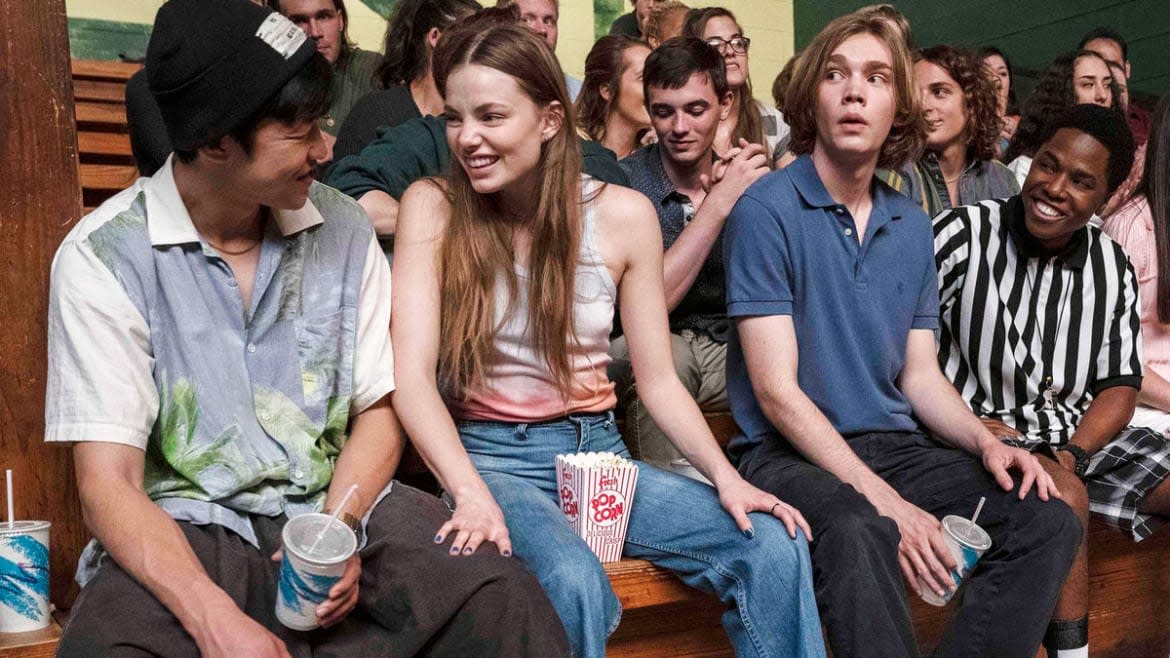Hulu’s ‘Looking for Alaska’ Is Just the Right Kind of Sappy-Yet-Self-Aware Teen Drama

When Miles Halter, the protagonist of the new Hulu miniseries Looking for Alaska, first lays eyes on Alaska Young from the backseat window of his parents’ car, he’s smitten, though he, and the audience, have no way of knowing in that moment just how deeply she will change his life. It is a scene plucked straight from the vivid, highly romanticized fantasies that only teenagers are capable of fostering, played out in slow motion to lilting instrumental music.
Alaska, bathed in soft, natural light that accentuates her ethereal beauty, is loading a crate of illegally purchased alcohol into the trunk of her car on the side of the road. After what feels like an eternity of unbroken eye-contact, Miles leans back against his seat, barely able to catch his breath. Much of the show’s eight-episode arc feels like this one sequence—beautiful and idealized, foreboding, and entirely relatable to anyone who recalls the intensity of being a teenager.
Looking for Alaska is the latest addition to the teen drama canon, adapted from the 2005 John Green novel of the same name. Miles, played by Charlie Plummer, is an introverted teenager who obsessively memorizes the famous last words of historical figures. Inspired by the pre-mortem avowal of French poet François Rabelais (“I go to seek a Great Perhaps”), Miles decides to leave behind his mundane life in Florida to attend Culver Creek boarding school in Alabama. Once there, he befriends Chip, nicknamed the Colonel (Denny Love), Takumi (Jay Lee), and—you guessed it—Alaska (Kristine Froseth).
The series, developed by Josh Schwartz and Stephanie Savage (The O.C., Gossip Girl), shows its cards early by beginning with a climactic car accident. The subsequent episodes take us back to the events leading up to the tragedy, each one labeled with the number of days remaining before it occurs. The effect is compelling, creating a creeping tension conducive to bingeing all eight episodes in one sitting.
Green is a deft craftsman of page-turning YA melodrama and, arguably, one of the foremost translators of the manic pixie dream girl trope into adolescence. Alaska Young would not be out of place among Rocky Horror-loving Sam from Stephen Chbosky’s The Perks of Being A Wallflower or Kate Hudson’s teenage groupie Penny Lane in Almost Famous. Though Looking for Alaska was his first hit, and widely considered his best novel, Green is best known for penning The Fault in Our Stars, about two teens who fall in love after meeting at a cancer support group.
The pairing of Green’s poignant, though occasionally trite source material with the creative minds behind The O.C. works seamlessly. Schwartz and Savage are no strangers to precocious adolescent characters who communicate exclusively via unbelievably witty dialogue and obscure cultural references. That the performative pretentiousness of the gang of misfits in Looking for Alaska is played as a thinly veiled guise for insecurity makes the unrealistic dialogue feel natural and self-aware—at least, most of the time.
The decision to make the show a period piece of sorts, setting it in 2005 when the book was published, is also an ingenious choice as it allows Schwartz to milk the early-2000s nostalgia evocative of the show that made him famous all those years ago. He does this primarily through the soundtrack, which is peppered with updated covers of Franz Ferdinand, Death Cab for Cutie, and Sufjan Stevens. An amusing swan attack sequence in the first episode is set to “Blue Orchid” by the White Stripes.
In Schwartz and Savage’s hands, Looking for Alaska actually manages to improve upon the original work—no small feat for an onscreen adaptation of a beloved book. While in the novel, the mysterious title character often seems to exist only in the imagination of the male narrator, never allowed to tell her own story or transcend two dimensions, the show brings Alaska into focus. Alaska’s interiority is explored on a deeper level, and viewers catch firsthand glimpses into her home life and her relationship with her long-distance boyfriend.
Miles is still the lens through which we access the world of Culver Creek, but we no longer rely on him entirely for our evaluations of the people around him. This is crucial, as nearly 15 years have passed since the book was published, and our collective tolerance for narratives about lost male leads being saved by beautiful, beguiling women (usually at their own expense) has dwindled.
Charlie Plummer, with his curtain of long, slightly greasy hair, eerily resembles a young Chad Michael Murray in cargo shorts and does a perfectly fine job as Miles. But often it is the supporting cast that steals scenes, particularly newcomer Denny Love as Miles’ assertive, prankster roommate the Colonel and Veep alum Timothy Simons, who plays the merciless school principal with hilarious earnestness and empathy. No one, however, is as magnetic as Kristine Froseth in the title role. As the narrative quietly plummets towards tragedy in the series’ first few episodes, Froseth is its emotional center, able to convey the pain beneath her character’s self-assured exterior with just a fleeting look.
Montages of the friends smoking cigarettes under a bridge, gleefully planning prank wars, and burying cheap bottles of rosé in the woods for safekeeping will make you nostalgic for the high school experience you never had. And then, though you know it is coming, the inevitable tragedy in the later episodes is sure to thaw even the coldest of hearts. Fans of John Green, The O.C., and everyone in between will not be disappointed by this excellent addition to a genre of television that is notoriously difficult to get right.
Got a tip? Send it to The Daily Beast here
Get our top stories in your inbox every day. Sign up now!
Daily Beast Membership: Beast Inside goes deeper on the stories that matter to you. Learn more.

